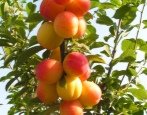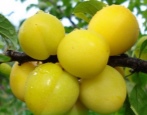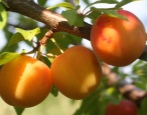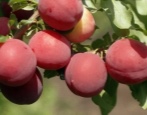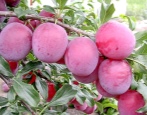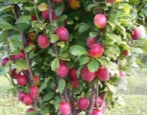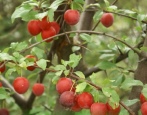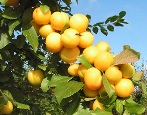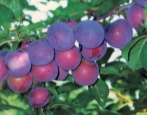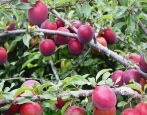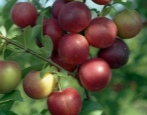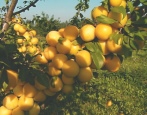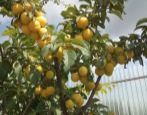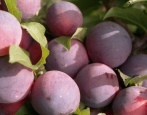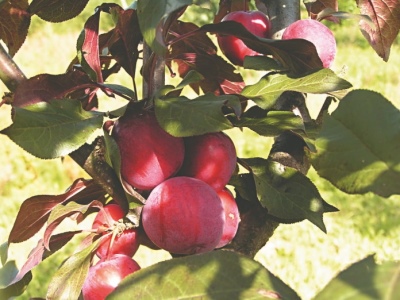
- Appeared when crossing: Seedling 9-250 (Pr. Cerasifera var. Pissardii) x A mixture of pollen of promising hybrids from crossing P. ussuriensis x (P. salicina x P. cerasifera)
- Ripening period: mid-late
- Self-fertility: self-infertile
- Fruit size: large
- Yield: fruitful
- Appointment: for fresh consumption
- Fruit weight, g: 30
- Fruit shape: rounded oval
- Fruit color: dark purple, almost black
- Skin : with a strong waxy coating
Breeding works are constantly replenishing the catalogs of fruit and berry crops with new varieties with unusual properties. These include the universal variety of cherry plum Lama, which has a high decorative effect. Obtained by combining seedling 9-250 (Pr. Cerasifera var. Pissardii) and a mixture of pollen of promising hybrids from crossing P. ussuriensis and (P. salicina x P. cerasifera).
The variety immediately fell in love with the gardener due to its high winter hardiness, amazingly large yields, and excellent taste. The sphere of use of the fruits is quite extensive - they are consumed fresh, they are suitable for deep freezing, after which they do not lose their qualities. Jams, compotes, preserves, jam are made from cherry plum. Used in confectionery (marmalade), in cooking (sauces, baked goods).
Description of the variety
A medium-sized (1.5-2 m) tree with a spreading flat-round crown, prone to thickening, has high decorative qualities at any time of the year and powerful fruiting. The crown is covered in deep red shades with a full range of blue-violet tones. The claret-reddish shade of the young bark of the plant darkens over time. The Lama blooms with fragrant deep pink flowers.
Fruit characteristics
Large (30 g) rounded-oval fruits are colored in a dark purple palette, almost black in the bright sun. The peel with many subcutaneous dots of gray color is covered with a dense bloom of pruin, the bone is well separated from the pulp.
Taste qualities
Juicy dark red pulp has a fibrous consistency, has a surprisingly sweet taste, balanced by moderate acidity. The variety received a relatively high rating from tasters - 4.4 points out of 5 possible.
Ripening and fruiting
Llama belongs to the mid-late ripening category - the beginning of the harvest is in August. Fruiting begins 2-3 years after budding in the nursery.
Yield
The declared yield of the variety is average - up to 25 tons per hectare, however, practice has shown that ideal agrotechnical conditions are capable of raising the yield of an adult tree to 300 kg.
Growing regions
Thanks to the selection of cherry plum, Lama has an amazing winter hardiness for a southerner and the ability to produce crops even in a short summer; its cultivation area has expanded from the Central Black Earth Region and the middle zone to the Urals, southwestern and southeastern Siberia.
Self-fertility and the need for pollinators
Self-infertility of Lama requires proximity to pollinating varieties - Mara, Asaloda.
Growing and caring
In order for the tree to develop well and give full-fledged harvests, attention should be paid to the neighborhood with a number of growing crops. Cherry plum favors "cooperation" with currants and thyme, since the shrubs successfully resist the spread of weeds. Flowers such as tulips, primrose and other primroses not only adorn the trunk circle, but also fade much earlier than cherry plum, do not compete with it in the fight for nutrients. But the antagonists are walnut, hazel, birch, conifers, poplar, pear. All of them consume a lot of organic matter and trace elements, and also secrete substances that are poorly tolerated by cherry plum.
The plant is planted in spring and autumn in well-lit southern areas with fertile, breathable soil. For the variety, acidic soil, swampy lowland areas, proximity to groundwater (no closer than 1.5 m to the surface) are contraindicated. The increased acidity is neutralized with dolomite flour, chalk, lime fluff at the rate of 2 kg per square meter.
The planting hole is prepared based on standard dimensions - 50x50x60 cm.At the bottom, a drainage layer of at least 10 cm high is arranged. At the same time, a support is installed for young seedlings. The removed fertile layer is enriched with organic matter (humus, compost), river sand, and leafy soil is added. The free space in the pit is filled with ⅓ of the resulting mixture, a seedling is installed, the roots are gently straightened, if it is an ACS, and covered with the remaining soil, compacting it and pouring 20 liters of warm water. After the moisture has been absorbed into the ground, the trunk circle should be covered with a 5 cm layer of peat mulch. Peat can be replaced with straw or cut grass. Further care of the crop consists in timely watering, feeding, preventive treatments and pruning.
Watering a young plant is carried out at intervals of 1 time in 2 weeks, excluding prolonged rainy weather. A plant over two years old needs additional irrigation only during a drought period. Regular waterlogging threatens the appearance of aphids, damping of the bark and weak fruiting. Unlike many fruit trees, cherry plum is not watered for the winter.
The introduction of additional nutrients is carried out three times during the season:
in spring, the culture is fed with nitrogen fertilizers, stimulating the growth of vegetative mass;
before flowering, cherry plum is fed with aged infusion of mullein (1: 10), carrying out the procedure after watering so as not to burn the roots;
autumn is the time for the introduction of complex mineral fertilizers, designed specifically for fruit and berry horticultural crops.
Formative pruning is used to increase yields. At the same time, up to 10 skeletal branches are removed, the shoots are shortened annually, achieving a well-formed bush. Bearing in mind that cherry plum is prone to growing a large number of shoots, the crown should not be allowed to thicken - the plant should be provided with free access to sunlight and air.
Sanitary pruning is done in the spring. At this time, frozen, damaged, broken, deformed and dried shoots are removed.
During a prolonged drought, care must be taken to cover the trunk circle with a thick layer of mulch. During the change of mulch, the previous layer is dug up together with the ground, immersing the bayonet of the shovel no more than 5 cm, since the root system is located quite close to the surface. In autumn, the trunks and part of the skeletal branches are whitened with a specially prepared composition - a mixture of lime, copper sulfate, casein glue. Such a technique will help to cope with some of the pests, protect the bark from burns by aggressive sunlight in early spring. The thin bark attracts rodents in winter, so it is necessary to organize the protection of the lower part of the trunk. To do this, you can use a special mesh, a woolen casing wrapped on top with a sheet of iron and wrapped in burlap. The bottom of the protection must be submerged in the ground.
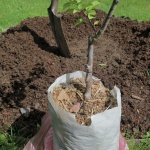
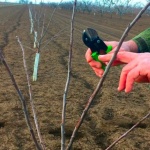
Disease and pest resistance
The variety is well resistant to fungal diseases and pest attacks. It is noticed that cherry plum fruits are not damaged by feathered gourmands. A little worse Lama resists clasterosporium disease. A particular danger is posed by such aggressors as:
cherry plum aphid;
brown fruit mite;
leaf roll and false shield.
In the fight against them, preventive treatments with insecticides and fungicides will help.
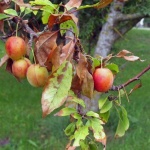
Requirements for soil and climatic conditions
Cherry plum Lama has high winter hardiness (up to -36ºC), copes well with temperature extremes, changing thaws and frosts, drought-, heat-resistant (up to + 40ºC).


